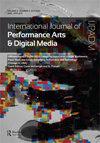Zoom剧院的“窗帘、音乐和舞台”:科尼的《电话》中的框架装置
IF 0.9
0 THEATER
International Journal of Performance Arts and Digital Media
Pub Date : 2022-12-29
DOI:10.1080/14794713.2022.2162273
引用次数: 1
摘要
科尼的互动数字作品《电话》由塔索斯·史蒂文斯创作和表演,于2020年4月在英国第一次封锁期间首演。它通过视频会议平台Zoom进行表演,采用了传统的框架设备,如开场白、开场音乐、替代舞台幕布和虚拟剧院酒吧。本文拟考察这些戏剧惯例在《变焦》制作中的作用。提交人认为,这些设备不仅用于其通常的戏剧性目的,而且还为数字媒体和大流行病的特殊情况调整了新的功能。他们向观众介绍了戏剧性的情况和封锁的背景情况,以便提供关键的技术指导,在熟悉的家庭空间和网络空间中构建表演,并寻求他们对作品的不同寻常形式的理解。通过对这些传统框架装置的明确和强调,这部作品激活了观众对戏剧存在和再现双重秩序的意识,从而构建了一种现场戏剧体验和共临感和团聚感,这在剧院封闭和社会疏远的时代显得尤为重要。本文章由计算机程序翻译,如有差异,请以英文原文为准。
‘Curtains, music and stages’ in Zoom theatre: framing devices in Coney’s Telephone
ABSTRACT Coney’s interactive digital piece Telephone, created and performed by Tassos Stevens, was premiered in April 2020 amidst the first lockdown in England. Performed via the videoconferencing platform Zoom, it employs conventional framing devices such as a prologue, opening music, a surrogate stage curtain and a virtual theatre bar. This paper intends to examine the functions of these theatrical conventions in the Zoom production. The author argues that these devices are used not only for their usual dramatic purposes, but are also adapted with new functions for digital media and the special circumstances of the pandemic. They inform the spectators of the dramatic situation and the contextual situation of lockdown, in order to provide crucial technical instructions, to frame the performance within familiar domestic spaces and cyberspace, and to seek their understanding of the unusual form in which the piece is made. By the explicit and emphatic use of these conventional framing devices, the production activates the audience’s consciousness of the theatrical dual orders of presence and representation, so as to construct a live theatre experience and senses of co-presence and togetherness, which are all the more significant during a time of theatre closure and social distancing.
求助全文
通过发布文献求助,成功后即可免费获取论文全文。
去求助
来源期刊

International Journal of Performance Arts and Digital Media
Arts and Humanities-Visual Arts and Performing Arts
CiteScore
1.70
自引率
0.00%
发文量
29
 求助内容:
求助内容: 应助结果提醒方式:
应助结果提醒方式:


